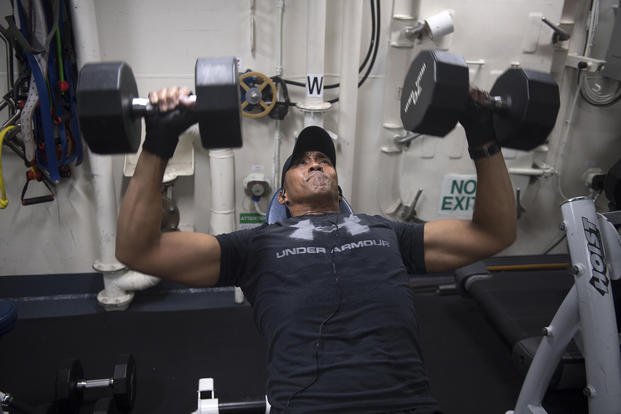The primary reason people start lifting weights is to put on muscle mass. Whether you are an endurance athlete or never have trained in fitness or athletics before, the weight room can hold the answer to many of the health, wellness and overall confidence issues that many teens encounter.
Here is a great question from a young man who has military service in his future and wants to be fully prepared for that career decision.
Stew, I am a solid runner and can PT well as I have always been an endurance athlete (runner and swimmer). However, I am 6'1" and 155 lbs. and need to put on some mass. I am only 19, so I may have some growing to do. What are the best weight training splits for putting on mass? Thanks, Steven.
Steven, nice effort with training for endurance and muscle stamina (work capacity) throughout your teens. You should be glad that you have above-average ability in those two elements of fitness, as many of your future tests will involve running distance, calisthenics tests and perhaps even swimming, depending on the branch of service. Having a foundation in strength training will be a requirement for many of the demands of a military career, as it is the source of overall bone and joint durability.
With any new activity, it is wise to have a logical progression. Resistance training takes many forms, and you can build muscle with calisthenics, weight vests and sandbags as you get started. Here is an example:
Calisthenics (with Weight Vest)
Adding a weight vest to your calisthenics workouts is the first step to making calisthenics harder. Weighted pull-ups, push-ups, dips, squats and lunges are five classic exercises that can be a source of a push/pull/leg split routine.
Do all the pushing exercises you can think of on Monday. The pulling exercises can be done on Tuesday and the leg exercises can be done on Wednesday. Repeat the push/pull/leg for the next three days of the week and rest on Sunday.
Another option is to make a "rest day" a floating day and place it where and when needed most during the week but continue the push/pull/leg split after the rest day.
Dumbbells, Sandbags and Kettlebells
These three pieces of exercise equipment are affordable and will diversify your training options. Utilizing the same split routine above, you can now add in additional pushing exercises such as military press, triceps extensions, bench press, chest toss of sandbag and others. Pulling exercises that can be added are biceps curls and bent-over rows.
For legs, add chest-carry lunges (sandbag), kettlebell squats, Romanian deadlifts, dumbbell or kettlebell farmer walks up and down stairs, kettlebell swings and many more. Another option with a sandbag is to place it into a backpack and start a progression of rucking (making walking harder) and build some load-bearing durability.
Weight Training
You will have an option to lift with barbells or machines. A mix of both is also a wise beginner option, as some movements may be uncomfortable at first if you are new to the weight room. In the gym, you can find dozens of additional options to make your push/pull/leg split routine even more diverse.
From cable rows and pushdowns to barbell deadlifts and belt squats, there are too many options to fit into any workout session. The solution is to find lifts and exercises you like to do and keep the set and repetition ranges between 3-5 sets and 12-15 repetitions of everything.
Some other split routine ideas:
Upper/Lower Split
- Monday, Thursday, Saturday: upper body (mix of calisthenics and lifts)
- Tuesday and Friday: lower body
Wednesday and Sunday can be rest, or you can focus on cardio, flexibility and mobility. Keep sets and reps in the higher range with lighter weight if you are focusing on building mass at first.
Bodybuilding Split
One body part each day once a week.
Monday: Chest day (push-ups, bench, flies, incline bench, dips, etc.)
Tuesday: Back day (pull-ups, pull-downs, rows, variety)
Wednesday: Shoulders and traps day (military press, lateral raises, shrugs)
Thursday: Legs and abs day (squats, lunges, leg press, leg extensions and curls, planks, farmer walks)
Friday: Biceps, triceps and forearms day (curls, extensions, hanging, grip exercises)
Saturday and Sunday: Rest days or makeup days
There are many ways to build muscle, but the best way is the one you do consistently. You should also add more calories to your diet, so you can increase your muscle size. An additional 3,500-calorie surplus a week will add a pound of mass at the end of the week. That means consistently adding 500 calories a day if you want to gain weight. At 19 years old, being a "hard gainer" is still possible, so the weight gain will be a combination of working with more resistance and eating more food (protein, carbs and fat).
-- Stew Smith is a former Navy SEAL and fitness author certified as a Strength and Conditioning Specialist (CSCS) with the National Strength and Conditioning Association. Visit his Fitness eBook store if you're looking to start a workout program to create a healthy lifestyle. Send your fitness questions to stew@stewsmith.com.
Want to Learn More About Military Life?
Whether you're thinking of joining the military, looking for fitness and basic training tips, or keeping up with military life and benefits, Military.com has you covered. Subscribe to Military.com to have military news, updates and resources delivered directly to your inbox.


















